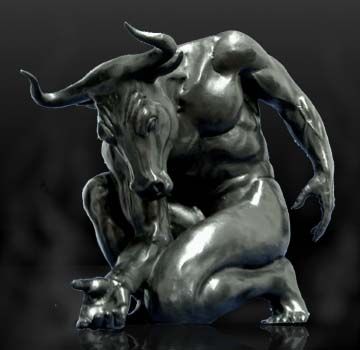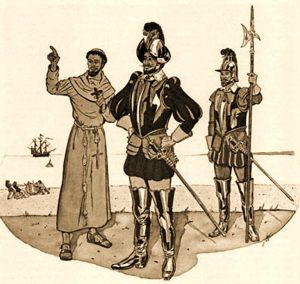When people talk about the ancient mythological creature Minotaur, a ferocious beast immediately comes to mind and perhaps the infamous myth of the labyrinth as well. What people may not know, though, are the interesting details of the events that lead up to the birth of the mighty Minotaur. What is universally recognized as a feared creature of unusual birth was actually created from unfortunate actions between a selfish king and a vengeful god.
King Minos and his wife Queen Pasiphae led a good life ruling over the island of Crete. Minos held power over multiple islands of Greece and was recognized for his success and power by many. In an attempt to prove his rightful claim as King of Crete, Minos had sworn to locate the best bull he could find among his cattle, one that would be very favorable to its intended receiver. Minos would then take this great bull and sacrifice it to Poseidon, god of the seas, as he did each year in order to secure his ownership of the throne. One year in particular, among King Minos’ herd, there birthed a magnificent bull, one that possessed a unique kind of beauty that King Minos had never seen before. Minos truly was in awe of this magnificent bull, so much so that he found himself captivated by its beauty, and he realized that this bull was something he did not want to give up to the promised Poseidon. In fact, Minos purposefully chose to overlook the magnificent bull when making his decision, and settled on a less attractive bull to sacrifice to Poseidon.1

Watching him and his deceitful actions very closely, Poseidon took notice of King Minos’ plan in sacrificing a lesser bull to keep the best for himself. This made Poseidon very angry, and he immediately began thinking about how to discipline Minos for his selfishness. Poseidon saw that Minos loved his wife Pasiphae immensely, and with this knowledge, constructed a plan that would leave Minos and Pasiphae in the presence of a monster. 2
Poseidon cast a curse upon Queen Pasiphae, one of love, which she could not escape. Her love was not for her husband; instead, she felt love for his magnificent bull. Pasiphae would be found swooning over the magnificent bull as if it were a handsome and powerful man ready to take her into his strong arms. Alas, she was so utterly infatuated with the magnificent bull that she constructed a plan to lure the bull towards her, and hopefully lay with her romantically.3
Queen Pasiphae instructed a craftsman of the island, Daedalus, and his son, Icarus, to build her a wooden structure that represented a near-perfect body form of a female bull. She insisted that the piece be built as realistically as possible and large enough for herself to comfortably fit inside without revealing that she was human. In spite of her odd orders, Daedalus and Icarus did what the Queen asked of them. As a finishing touch, Queen Pasiphae placed a large cow hide over the structure so that the magnificent bull would notice the structure and take it as a female looking to mate. The Queen rolled the structure out to the field where she would often see the magnificent bull grazing day after day. She strategically placed herself in the view of the magnificent bull, stepped inside the structure, and waited patiently for the bull’s approach.4

After grazing for a bit, the magnificent bull caught sight of what it thought was the beautiful female and approached it. Before long, the Queen’s plan worked, as the magnificent bull fastened itself upon her and together, engaged in sexual and intimate relations. As a result of this, Queen Pasiphae became pregnant with the baby of the bull and upon its birth realized she was carrying something horrific inside of her.5
Just as Poseidon intended, Pasiphae had relations with the bull she loved and later birthed an unusual creature, born half-bull, half-human to be known as the Minotaur.

The creation and birth of the Minotaur, as well as other monsters, typically is done in response to acts of sin. In this particular case, King Minos’ egotistical actions led him to break a promise made to a god, and in return, that god made Minos’ wife feel the same love that her husband did for the magnificent bull, giving in to her abnormal fascination and eventually birthing an infamous monster of ancient Greece.6
- UXL Encyclopedia of World Mythology, 2009, s.v. “Minotaur.” ↵
- UXL Encyclopedia of World Mythology, 2009, s.v. “Minotaur.” ↵
- Christian Moevs, “Centaurs, Spiders and Saints,” in Vertical Readings in Dante’s Comedy: Volume 2, edited by Corbett George and Webb Heather (Cambridge, UK: Open Book Publishers, 2016), 14-17. http://www.jstor.org/stable/j.ctt1sq5vb5.7. ↵
- UXL Encyclopedia of World Mythology, 2009, s.v. “Minotaur.” ↵
- Christian Moevs, “Centaurs, Spiders and Saints,” in Vertical Readings in Dante’s Comedy: Volume 2, edited by Corbett George and Webb Heather (Cambridge, UK: Open Book Publishers, 2016), 14-17. http://www.jstor.org/stable/j.ctt1sq5vb5.7. ↵
- George Palmer Garrett, “The Function of the Pasiphae Myth in Brother to Dragons,” Modern Language Notes 74, no. 4 (1959): 311-13. doi:10.2307/3040070. ↵



134 comments
Dayna Valdez
Very well written and interesting article.I always enjoy reading about greek mythology. I have always known about the minotaur but after reading this article, I got a better understanding of who he really was. It’s very interesting of how a monster came to be over a spell. It is even more interesting to think of a queen with a bull.
Zeresh Haman
I have never heard this story before, and it is an interesting one. I think the author did an amazing job of telling this story. I have seen and heard of the Minotaur, but have never heard the entire story in great detail. This article had a way of keeping me interested and had me wanting to keep reading. It was very captivatiing.
Samman Tyata
Great article! I really liked your article a lot. Honestly, I had no any prior knowledge about the Minotaur before reading this article. Your article was really informative for me. Greek mythology is something that has always been very interesting to me. It was a strange story to read that Minotaur was born from the relations of a human queen and a bull. To sum it up, it was a good read.
Rafael Azuaje
King Minos decided to lie to the Gods. I bet he came to regret that choice real quick. Some game and film art directors use the idea of the Minotaur as a basis for design when coming up with strong, but unintelligent characters. I have read about Greek mythology this semester a lot more than I had before. It’s amazing how well these stories have stood the test of time.
Alejandra Mendez
I had heard of a minotaur before, but I never knew the whole story or legend of the minotaur. Now that I have read it, I’m not sure what to think. It is definitely an interesting one. It has a very surprising plot twist as well. When I began reading the part where Poseidon was angry and wanted to get revenge on King Minos, I thought he would turn Minos half bull because he was so obsessed by the bull’s beauty. Now I know Poseidon is a lot more cruel than I thought he was.
Ernie Sano
Great job on the description of the story behind the Minotaur. Greek mythology is always a joy to read and I find it exciting to see people going into detail of the stories and myths created. The picture choice was appropriate and your story telling skills made this article a great read. I look forward to further articles with this type of skill and dedication.
Ryann Cervantes
I like the lesson behind the story and the parallel Poseidon implemented by having the wife love the bull like how the king did. It surely wasn’t what I thought was going to happen but that helped the story be that much more unexpected. I also like how you mention that most stories have the core sin as the reason for whatever situation arises. I think it would be an interesting thing to do if you could also write about the story of the Labyrinth that was created to hid the Minotaur and the story of Icarus flying too close to the sun.
Alexis Renteria
I knew about the Minotaur but I did not know how it was created. I found it interesting how even back then a person could fall in love with an animal and would be willing to do anything to keep it as we do today with our pets. I found it disgusting what Poseidon did to Queen Pasipahe and I feel like Minos should have been the only one punished, but I guess that’s what happens when you decide to disobey the gods. Overall, this was a very well written and fun article to read and I’m glad I came across it because I enjoy reading about greek mythology.
Tyler Sleeter
Very interesting article. I am familiar with the Minotaur, but I had never heard the story of his birth before. It is interesting that he came about all because of the King Minos refusing to sacrifice his favorite bull to Poseidon. I like how Poseidon messed with Pasiphae’s head to make her fall in love with the bull. The rest of the story is also quite interesting but not surprising given the amount of times Zeus took the form of an animal to have relations with a women. Great story.
Veronica Spryszynski
Interesting article, you explained how things were in the story. Before I only knew how it looked like but not even the name or story of the Minotaur. I was surprised about Pasipahes decisions and disturbed also. I wonder if the king was anger at her for if he was okay with the outcome since he broke a promise with Poseidon.